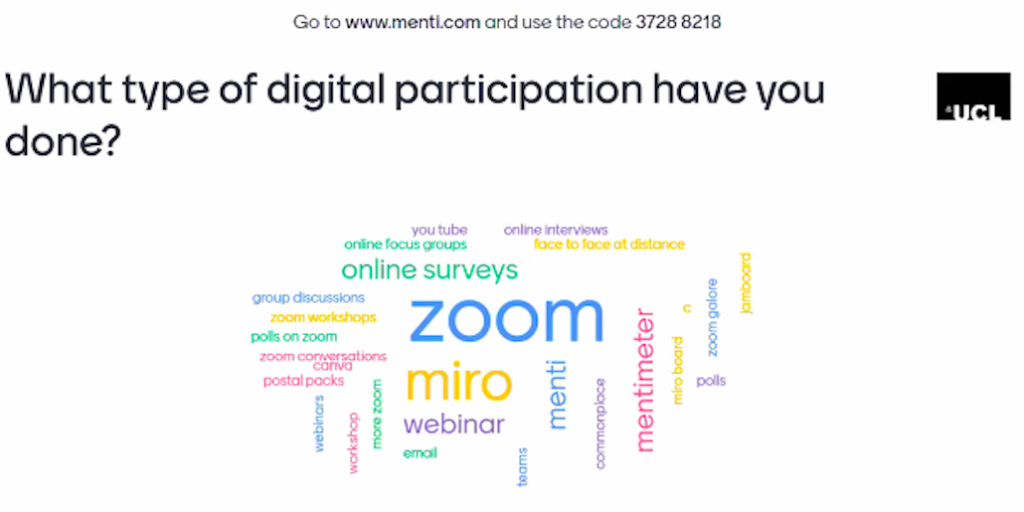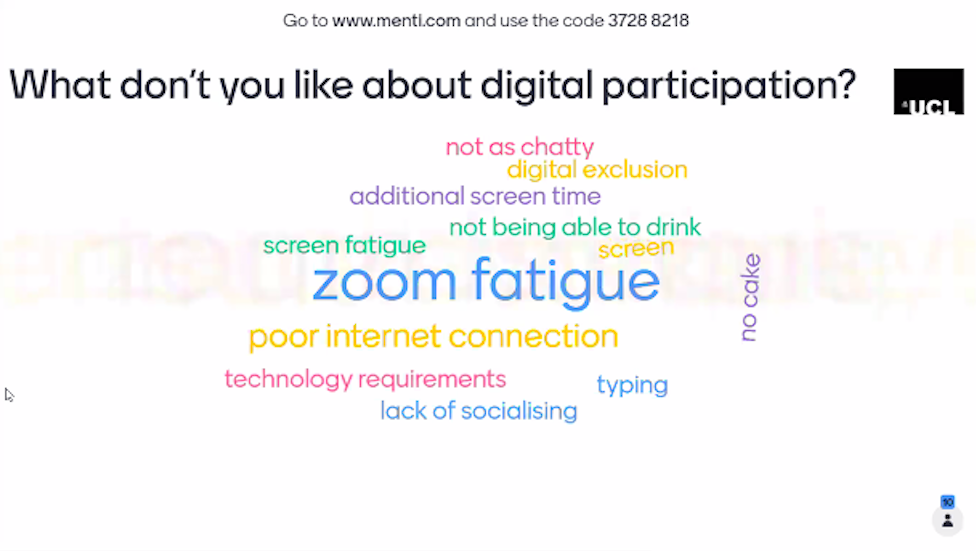Written by:
On Thursday 25 March, we hosted Co-Design in The Time of Covid, our final event in our We Design 20/2021 event series, Co-designing Sustainable Places. We’ve been experimenting with different methods and technologies during this series due to the Covid pandemic, and this was a space to reflect on the integration of technology in events, education, our working lives and in shaping our places.
Almost a year to the day of the first lockdown, the students and lecturers from our previous events reconvened to discuss the series as a whole and the role of digital tools in placemaking over the past year and to consider active engagement and co-design in the future.

We were joined by attendees from all over the world, including Australia, Panama and Chile. Our UK-based attendees joined us from Devon, Bristol, Dunblane, London and beyond. This is one of the wonderful things about using digital spaces.
Reflections from Tutors and Students
This event series has been dramatically different from previous years for The Glass-House, and working in an online landscape has opened up new possibilities for the students involved.
Each lecturer who steered one of the events in the series was invited to recap the event theme, its ethos, student projects and how they felt about the impact of Covid on community engagement and co-design. One student facilitator from each event also shared their thoughts.
They shared their reflections that participating in our events gave them a chance to connect with people outside the university context and exposed them to a kaleidoscope of people from varied backgrounds and locations, thus further enriching both our conversation and their studies.
This also gave them a chance to learn from people in practice in an informal experimental learning space, giving them a platform to test their ideas and their work on projects already delivered. Such spaces for connection also offer them the opportunity to showcase the contribution that students can make to these important societal questions and conversations, and some of the tools they can help inject into processes.

New Technologies, experimentation and UCL Student Research
Throughout the series we’ve been experimenting with Zoom and Miro to create a more engaging and interactive online experience. While Zoom aids the conversational side of each of the events, Miro helps create an online workspace for collaboration and to pinpoint and share findings visually, especially when presenting and working on co-design activities as in our events. Student facilitators guided our participants along the way, whilst helping those less comfortable with the technology remain engaged with the discussion.
In this event we tested out Mentimeter to help aid the UCL students’ research. The platform helps users create interactive presentations via live polls, quizzes, word clouds, Q&As and more.

A group of UCL Bartlett planning students presented their initial research entitled “Understanding Public Participation and the Pandemic”.
Thoma and Thomas began by setting the scene. The brief was to explore the notion of digital participation during the pandemic.
The students were keen to explore moving from traditional in-person engagement techniques to online tools, how both project managers and participants have adapted, and how long it’s taken. The legacy of the new methods was also questioned, and they proposed hybrid models would be the way forward, using the most popular tools which were video calling platforms, Miro, social media and survey tools.
The challenges and expectations relating to online community engagement also arose. It was agreed that we need to learn from the past year and to understand best practice for participation as we step into the new normal, to ensure these processes are inclusive and accessible to all.
Through their research, the students are interviewing practitioners to ask them about their experience of online participation before and after Covid, and they have encountered some unexpected findings. They have found, for example, that street surveys often have a more diverse range of participants than online events. Surprisingly, some reported that there was an increase in retired people partaking in online consultations, but not a similar increase in participation from younger people, possibly as older retirees have more free time than young professionals. They also shared some of the logistical challenges and opportunities of going digital. The ability to record sessions and create follow-up documents online means more people are reached, however, the issue of digital literacy means access is still a problem and facilitators may need extra training when it comes to utilising new tools.
Eleanor led us into the interactive section of the event using the tool Mentimeter. We found the attendees shared an overwhelming preference for using hybrid approaches once we’ve all emerged from Lockdown. Many of the attendees had used Zoom, Mentimeter and Miro over the past year for projects and events. You can see some of the colourful word maps that developed below.


Exploring the wider landscape of online participation
We then opened the floor for free-flowing conversation on how the attendees felt about the sudden digital shift in participation and placemaking. Throughout the event certain themes developed;
- Thinking about the medically vulnerable, and how they can have their say.
- Human centred design, using it to look at pressing issues such as Climate Change. Designing for the more than the human, recapturing our relationship with nature, and the complex systems that make up our world.
- Encouraging cultural, skill and knowledge exchange among different groups to create long-lasting and meaningful change.
- How catalysts such as the ‘Me Too’ and ‘Black Lives Matters’ movement have made us think about projects in different ways, such as thinking about safe spaces for women and increasing diversity.
- How new innovations such as Low Traffic Neighbourhoods have thrived and approaching the environment in different ways and repurposing urban environments.
- Civil self-empowerment and organising, which has seen the development of Mutual Aid groups and What App groups take charge of improving their local space and community for the better. More citizens have been using their collective power for good.
- One talking point raised was that some personalities will feel more encouraged to speak out online, especially as there are a number of ways to communicate, for example in Zoom via chat, private message or just speaking aloud.
- The notion of the 9-5 was wracked, as many workers no longer worked in a linear way. One attendee who works alongside the health sector mentioned when working with children, sessions take place on a weekend, which means clinicians may be excluded from said sessions. Thus digital tools can’t always solve the issue of being apart.
- Zoom fatigue came up as one of the factors the attendees disliked about online participation. One guest likened Zoom’s void of interaction, to being on the outside looking in from a window.
- Of course, the generational divide came up in conversation. Where possible, co-design events should be interactive spaces in which people of different ages, backgrounds and experiences converse and share.
- In particular, when working with young people and children, gaming workshops have been used in the past to engage the young participants, but to also let them feel comfortable about sharing their thoughts and ideas when it comes to creating or updating a local space. Augmented and Virtual reality should also be explored in regards to bringing different people in various places into one (virtual) place together.

Summing Up
The hour and a half flew by as we chatted about this rich topic. There is still much to innovate and study in regards to online participation. We’ll probably have a few months yet to discover and play with new tools and platforms, however with so many online conference calls happening, we should not only think about best practice with new technologies, but we must also find new ways to interact with each other.
These tools should bring us together and not cause a sense of isolation. Simple things such as playing music, games, initiating chat use by asking questions, polls and breakout rooms can break the monotony of too many samey calls. Really the key is injecting a bit of fun, especially in these ever-changing and somewhat stressful times.
Our event series has shown the potential of experimentation online, and an excellent opportunity for students to put into practice their research, gain some real world experience and to inject new energy into the mix.
“The way the meetings have been run has been refreshing and engaging, with it being not restrictive or constrictive how other online talks/ discussion have been.”
Event Attendee
“Excellent way of bringing people in and offering opportunities for participation to each and everyone.”
Event Attendee
“Really welcoming space and always a great experience with Glass-House events.”
Event Attendee
We’d like to thank all the tutors involved in the series, which include Lucy Natarajan (University College London Bartlett), Lizete Druka (The Glasgow School of Art), Leo Care (University of Sheffield), Yasminah Beebeejaun (University College London Bartlett), our student facilitators and all the attendees for their participation and contribution to our event series.
If you would like to watch the event in its entirety, the video of the event here and the Miro Mind Map created by Elly, which captures our conversation, here. Please visit our events page for updates and registration information on our upcoming events.

